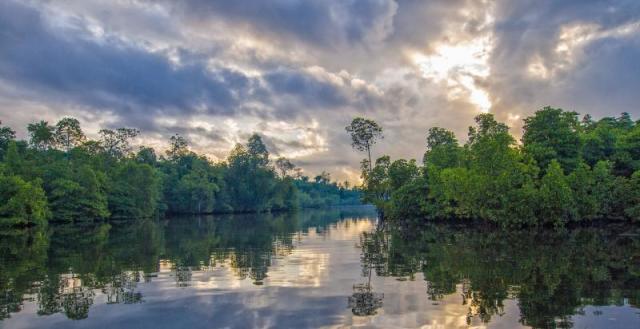A mangrove is a woody tree or shrub that lives along sheltered coastlines within the tropic or subtropic latitudes. In fact, the various species of mangroves aren’t necessarily closely related to one another, but they do share the unique capability of growing within reach of the tides in salty soil. Some mangrove species live so close to the shoreline that they are flooded with salt water every day as the tide comes in and submerges their roots. All mangroves have evolved special adaptations that enable them to live in salty, oxygen-poor soil.
Under the strictest guidelines, there are roughly 54 true species of mangrove belonging to 16 different families. However, because distinguishing a mangrove species is based upon physical and ecological traits rather than family lineage, scientists often differ in what they consider to be a true mangrove. Some species like Conocarpus erectus, the buttonwood, are often grouped with mangroves since they hug the upper edge of mangrove forests, however, they lack many of the characteristic adaptations of mangroves and are labeled “mangrove associates.” When all plants that live in a mangrove environment are accounted for, there are well over 80 mangrove species.
Mangrove can also be used as a term that refers to an entire community. The tree and shrub foliage create a rich habitat for other plants and animals to call home, and the branching root system underwater creates a safe haven for many fish, especially easily preyed upon young. Scientists will refer to this as the mangal, but mangrove or mangrove forest works just the same.
Mangroves grow in sheltered tropical and subtropical coastal areas across the globe. In general, this is an area between latitudes of 25 degrees north and 25 degrees south, however, geographical limits are highly variable depending upon the area of the world and local climates. In Eastern Australia, the mangrove Avicennia marina can grow as far south as 38 degrees and Avicennia germinans can grow as far north as 32 degrees in the Atlantic. A major restriction for where mangroves can live is temperature. The cooler temperatures of northern temperate regions prove too much for the mangroves. A fluctuation of ten degrees in a short period of time is enough stress to damage the plant and freezing temperatures for even a few hours can kill some mangrove species. However, rising temperatures and sea level due to climate change are allowing mangroves to expand their ranges farther away from the equator and encroach on temperate wetlands, like salt marshes. Also, on some isolated tropical islands, such as Hawaii and Tahiti, mangroves are not native and are sometimes considered invasive species.

